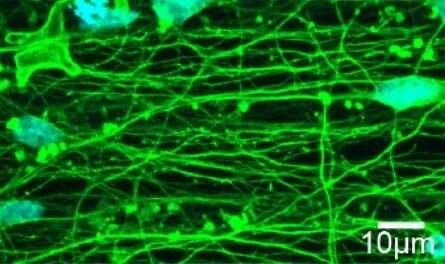Engineering nerve cells to study the relationship between shape and function in health and disease

Researchers at the Francis Crick Institute and King's College London have shown that the length of nerve cells is intimately connected with their function. Their accurate model allows the study of structural and functional processes in these cells, offering important insights into neurological diseases.
Motor neurons in the spinal cord are the target of several neurological diseases, such as amyotrophic lateral sclerosis (ALS). They can be up to 1m in length due to extremely long axons, slender fibers that extend from the cell. It has previously been observed that early signs of disease first appear at the end of axons, and longer axons show signs of disfunction before shorter ones. Studying long axons could therefore lead to a better understanding of some neurological diseases. However, studies in the lab to date have used cells that are much shorter than they are within our bodies.
In their study, published in Advanced Healthcare Materials (Thursday, 3 February), the scientists developed a bioengineering platform that allowed them to grow human motor neurons with defined axonal lengths, from hundreds of micrometers up to 1cm and above, without varying other meaningful characteristics.
Dr. Andrea Serio, lead author and group leader of the Neural Circuit Bioengineering and Disease Modelling Laboratory at the Crick and Lecturer in Neural Tissue Engineering at King's, says: "Being able to grow human motor neurons to 1cm and beyond, in a controlled fashion, provides a better model than using cells only a couple of millimeters, or even just some hundreds of micrometers long. Fundamentally, the simple question we wanted to address is, "Does it matter how long they get?'"
"The answer is yes. This is the first time it has been shown that the length of neurons is closely connected to its function. We'll be continuing to develop our platform with a hope to grow these cells to a longer length, which is even more representative of their size in the body."
Using their new platform, which involves growing neurons on a microfabricated substrate, the researchers were able to decide what length to grow these cells to.
They compared motor neurons of various lengths, between 2mm to 1cm. In the cells that were over 5mm long, there were significant changes in how they maintain cell activity, stability and metabolism. For example, above this length the neurons have more mitochondria and these are also more likely to stay in the same location rather than being moved around. And in some parts of longer neurons, more of these organelles are circular rather than elongated in shape.
Cathleen Hagemann, first author and Ph.D. student in the Neural Circuit Bioengineering and Disease Modelling Laboratory at the Crick and King's, says: "Our study starts answering the question if neuronal shape matters and also if the cell's function is adapted to it. The results so far are supportive of this hypothesis. There is a threshold length, of about 5mm, above which some key biological processes in the cell change or adapt."
Andrea adds: "One of the most interesting findings is this idea of a 'threshold length' that neurons need to reach before, essentially, switching gears in their metabolisms and certain mechanisms. If you compare the cell to a city, you'd expect a well-designed small city to have very different infrastructure compared to a large city, for example, how things are transported and how much energy it needs. Once you reach a certain size, infrastructure and services would change to adapt to the new challenge."
As this project progresses the researchers are now using their platform to grow neurons from cells donated from people with ALS, in order to create more accurate models of the disease and potentially better platforms to test new therapies. They are also carrying outstudies to determine if these mechanisms are conserved across species.
More information: Cathleen Hagemann et al, Axonal Length Determines Distinct Homeostatic Phenotypes in Human iPSC Derived Motor Neurons on a Bioengineered Platform, Advanced Healthcare Materials (2022). DOI: 10.1002/adhm.202101817



















